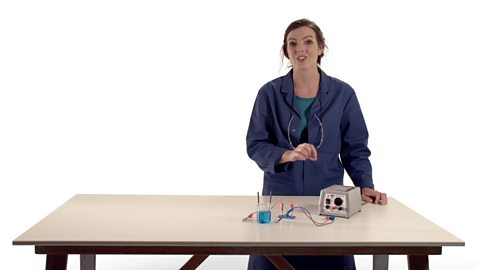How to titrate an acid and an alkali
Speaker one Neutralisation reactions take place in our everyday lives. For example, there are bacteria in your mouths that convert sugar in foods to an acid which can damage your tooth enamel. So toothpastes contain a base which neutralises the acid, protecting teeth. We will use titration procedures to determine the volume and concentration of a solution of sulfuric acid by neutralising alkaline sodium hydroxide solution. The sodium hydroxide is our solution of known concentration. We are using a concentration of 0.1 moles per decimetre cubed. The sulfuric acid is our solution of unknown concentration. We will need to accurately measure the volume of acid required to neutralise our alkaline. We will then use this information to determine the concentration of the sulfuric acid.
Speaker two For this experiment you’re going to need the following apparatus. So please pause and take a look.
Speaker one Now, before we get started, make sure you are wearing your safety goggles.
Speaker two And when pouring any chemicals, don’t ever fill above eye level to prevent chemicals splashing into your eye.
Speaker one When putting apparatus together, such as the pipette filler on the pipette, make sure to always face it away from your arm like this to avoid any accidents. We’re going to use the pipette filler to fill the pipette with 25 centimetres cubed of sodium hydroxide. Now we need 50 cubic centimetres of our unknown sulfuric acid.
Speaker two Ah, yes.
Speaker one I’m going to fill this up here.
Speaker two So we’ve closed the tap.
Speaker one Yeah.
Speaker two And I guess we’re over-filling it.
Speaker one Yeah, fill it just a little bit more because we’re going to open the tap and make sure we get any excess out.
Speaker two Okay, it’s just beyond zero now.
Speaker one Perfectamundo.
Speaker two
So I’ll take out the funnel.
Speaker one Funnel’s out. I’ll put that safely to the side. Okay. We’re going to make sure we get any excess out. All right, slightly open, slightly open. Yeah, and that’s zero.
Speaker two We need to add the indicator.
Speaker one Add the indicator, so that’s-
Speaker two Then give it a swirl.
Speaker one That is the phenolphthalein. All right, give it a little swirl.
Speak two Swirl, lovely. Now…
Speaker one OK. This goes under.
Speaker two On the white tile so we can see the colour nicely. We’re ready for titration!
Speaker one We’re ready for titration.
Speaker one
So, first we’re going to do a rough titration, OK? We will run the sulfuric acid into the alkali until we see the indicator change colour.
As you’ll see, the phenolphthalein goes colourless at the end point of this reaction.
Speaker two Okay, so that was 15.4.
Speaker one Okay, that is our rough one. We know it’s about 15.4. So when it comes time to doing the actual titration we know where it should roughly be.
Speaker two Yeah, so from about 14.5 we go quite slowly.
Speaker one Quite slowly.
Speaker two
Now refill the burette. Get a fresh batch of sodium hydroxide and indicator. And add the acid from the burette until you’re around 1cm³ below the rough titration end point.
Now add the acid a drop at a time, swirling the flask each time, until we see a permanent colour change in the indicator. Now note the volume of the acid added to the nearest 0.1 cubic centimetre. Make sure the scale is set at eye level when taking the reading. Collect three results that are close together to determine the volume of the acid when added, and then calculate the mean. If you’re studying the foundation course, you have now completed the required practical. However, if you’re studying for the higher level course, you may also be asked to determine the concentration of the acid. Pause and take a look at the steps you should follow to do this.
Speaker one We can calculate the concentration of the sulfuric acid that we used by dividing the number of moles of the acid by its volume. The sulfuric acid we used was 0.08 moles per decimetre cubed.
Speaker two And there you have it, that’s how we can use a titration to determine the volume and concentration of an acidic solution.
Description
A presenter-led science video showing how to titrate an acid and an alkali, with Dr Maggie Aderin-Pocock and Dr Alex Lathbridge.
Chemistry Practicals
Now playing video 3 of 5
- Up next4:57
